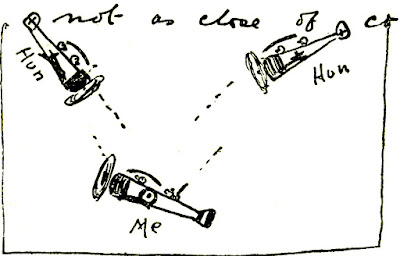Irene Foote Castle
Patria “Song” by Mrs. Vernon Castle -
NPG
This sheet music cover portraying Irene Foote Castle hangs in the National Portrait Gallery in Washington, DC.
One of the most popular dancers of the early twentieth century, Irene Foote Castle entered motion pictures as the star of the World War I drama Patria (1917). Prior to her acclaim as a screen actor, she and her husband Vernon Castle were widely known for their performance in Irving Berlin’s musical Watch Your Step, which appeared at the height of a dance craze in the United States. The couple popularized African American music among their well-heeled white followers, as their dances were often set to jazz and ragtime. Irene was also an iconic fashion figure, introducing the “bob” haircut worn by flappers in the 1920s. Vernon, who was a military flying instructor, died in an airplane accident in 1918, just before the end of World War I. Irene married three more times, continuing to make a name for herself in film. She spent her later years advocating for animal rights. -- NPG
Here's a photo of Mrs. Vernon Castle in the movie Patria, as she appeared in an ad in the Daily East Orgonian, February 14, 1917, in which she is identified as the “Best Dressed, Best Known Woman in America.”
Vernon and Irene Castle were known as “America's Dancing Sweethearts;” this Library of Congress photo shows Vernon Blythe Castle and his wife Irene dancing in July of 1914.
The Castles invented and performed a famous dance called “The Castle Walk.” In this photo
Mr. and Mrs. Castle demonstrate the Castle Walk for the Chicago Day Book in December 1913.
In his Day Book article, Vernon Castle gives this diagram showing the proper way to do the Walk without having your feet trodden by your dance partner. The trick requires dancing very close together, “with perfect propriety.”
“It sounds silly and is silly." wrote Vernon Castle in his 1914 book, Modern Dancing, “That is the explanation of its popularity!”
Similarly the Castles innovated this hands-free Tango:
Irene was often photographed with her pet monkey. The monkey's name, “Rastus,” reflects the casual racism of the times.
It's not clear to me whether Rastus is smoking a cigarette in the photo above or if that's just a flaw in the print.
Vernon who had been born Vernon William Blyth in England in 1883 (Castle was a stage-name), joined the Royal Flying Corps in 1917.
This headline in the Day Book, August 10, 1916, asks “Is a 'dancing man' Brave?,” and after listing the grueling tests required of an RFC pilot concludes that “Vernon Castle has the heartfelt thanks of dancing men, for by his example does not nimbleness of toe betoken possession of the stuff of which heroes are made?”
These sketches of WWI aerial combat by Vernon Castle appeared in letters sent to Irene during the war. They were published in Irene's book, My Husband in 1919.
After flying 300 combat missions and winning the Croix de Guerre, he returned to America to train American and Canadian pilots at Carruthers Field in Benbrook, Texas.
Bain News took took this photo of Captain Vernon Castle with his pet monkey Jeffery in front of a bi-plane.
The city of Benbrook tells the story:
On February 15, 1918, Castle was on a training flight with a cadet. As the cadet was landing, the plane's landing gear clipped the rudder of another plane that was taxiing to take off. Castle tried to take emergency action, but he was unable to get control of the plane, and it crashed into the ground, fatally injuring Castle. He died soon after, just 30 years old. -- Benbrook-tx.gov.
Vernon Castle's Plane, 1918
The Crash Monument in Benbrook says that “Neither the other pilot, his student cadet, nor Vernon's pet monkey, Jeffrey, were seriously injured.”
Vernon was buried at Woodlawn Cemetery in New York. Irene is (falsely) rumored to have posed for the naked figure, End of the Day, created by Sally James Farnham, on their monument at Woodlawn Cemetery. (photo by Hometown Handlebar)
My Beloved Hvsband
Vernon Castle Blyth
Born May 2, 1887
Was Killed Feb. 15, 1918
In the Service of His Covntry
RFC
Croix de Gverre
She married socially and financially prominent Robert Elias Treman months later and divorced him in 1923. She next married Frederick McLaughlin, coffee magnate and first owner of the Chicago Blackhawks. She is said to have created the “Indian head” logo associated with the team.
In 1926, as Irene Castle McLaughlin, she was proclaimed a heroine for rescuing her two year-old daughter Barbara by leaping with her from a carriage when the horse ran away with them. The article below appeared in the New Britain Herald, October 12, 1926.
Barbara McLaughlin Kreutz (1925–2003), grew up to be a professor of medieval history as well as Vice Chancellor at the University of Wisconsin-Madison and Dean of the Graduate School of Arts and Sciences at Bryn Mawr College.
In 1939 the film The Story of Vernon and Irene Castle was released, a musical starring Fred Astaire as Vernon and Ginger Rogers as Irene.
After the death of McLaughlin in 1944, she married business man and her former manager, George Enzinger. He died in 1959.
In these years Irene Castle became an animal rights-activist and humanitarian. She founded
Orphan's in the Storm, an animal shelter in Libertyville Illinois.
Hartsdale Pet Cemetery where many of her pets were buried says that “Near the end of her life, Irene Castle said in a magazine interview, "When I die, my gravestone is to say ‘humanitarian’ instead of ‘dancer.’ I put it in my will. Dancing was fun, and I needed the money, but
Orphans of the Storm comes from the heart. It’s more important."” And so when she died in 1969, her marker at Woodlawn Cemetery read: (See
Find-a-Grave)

Irene Castle McLavghlin Enzinger
Hvmanitarian
Born April 7,1893


















No comments:
Post a Comment